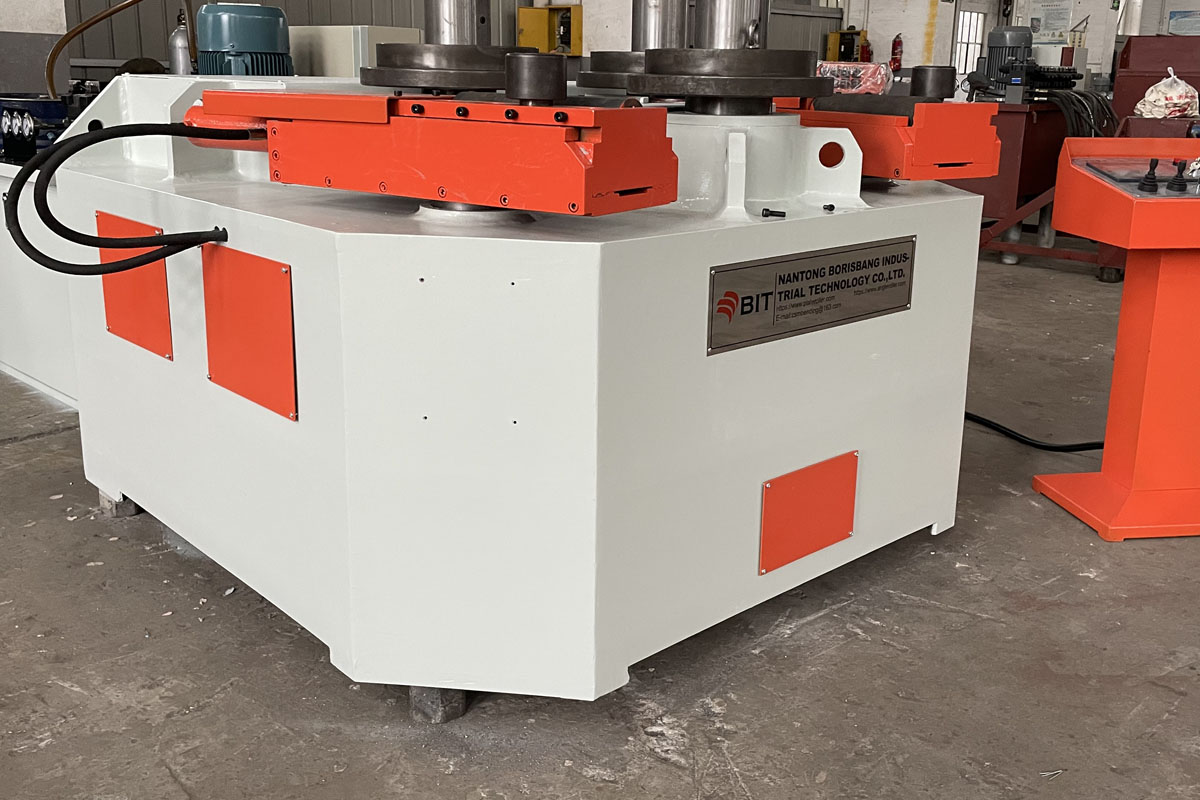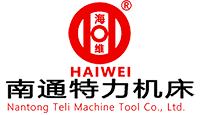型材折弯机各部件的性能和作用
型材折弯机是用于弯曲各种型材的机械设备。它主要由机身工作台、模具、液压系统、控制系统等几部分组成。通过调节折弯机构的参数,可以实现不同规格型材的折弯加工。
Profile bending machine is a mechanical equipment used to bend various profiles. It is mainly composed of several parts such as fuselage workbench, mold, hydraulic system, control system, etc. By adjusting the parameters of the bending mechanism, the bending processing of profiles of different specifications can be achieved.

型材折弯机各部件的性能和作用
机身工作台
- 机身工作台是型材折弯机的主要结构,应具有足够的强度和刚度,以确保设备在运行过程中的稳定性。
- 定期检查机身连接部位,确保螺栓、螺母等紧固件可靠紧固,防止松动影响设备的精度和安全性。
折弯模具
- 折弯模具是型材折弯机的关键部件,其质量和精度直接影响型材折弯的质量。
- 根据不同的型材规格和折弯要求,选择合适的折弯模具。模具的尺寸和形状应与型材匹配,以确保折弯效果。
- 安装折弯模具时,应确保模具安装位置准确、紧固可靠。同时,还要注意模具间隙的调整,避免型材在折弯过程中出现不均匀变形等问题。
- 定期检查和维护折弯模具,例如清理模具表面的油污和杂物,检查模具的磨损情况等。对于磨损严重的模具,应及时更换,以确保折弯质量。
液压系统
- 液压系统是型材折弯机的动力源,其性能直接影响设备的工作效率和稳定性。
- 使用液压系统前,应检查液压油的液位和质量,确保液压油符合设备要求。同时,检查液压管路是否有泄漏,如有泄漏,应及时处理。
- 操作液压系统时,应按照设备操作规程操作,避免操作不当造成液压系统损坏。
- 定期维护液压系统,例如更换液压油、清洗液压滤清器等。同时,注意检查液压系统的密封件。如有损坏,应及时更换,防止液压泄漏。
控制系统
- 控制系统是型材弯曲机的核心部件,其性能直接影响设备的自动化程度和操作精度。
- 使用控制系统前,应熟悉设备的操作界面和控制流程,确保设备能够正确操作。同时,应检查控制系统的连接线路是否正常。如有松动或损坏,应及时处理。
- 操作控制系统时,应遵循设备操作规程,避免因操作不当而损坏控制系统。例如,设置弯曲参数时,应根据型材的规格和弯曲要求合理设置,避免参数设置过大或过小影响弯曲质量。
- 定期维护控制系统,例如更新控制系统软件、检查控制系统的硬件设备等。同时,注意备份控制系统的数据,防止数据丢失。
传动系统
- 传动系统是型材弯曲机的重要组成部分,其性能直接影响设备的工作效率和稳定性。
- 使用传动系统前,应检查传动部件的润滑情况,确保润滑良好。同时,应检查传动带或链条的张紧度是否合适,如有松动,应及时调整。
- 操作传动系统时,应按照设备操作规程操作,避免操作不当造成传动系统损坏。例如,启动设备前,应将传动系统调整至空挡位置,然后逐渐加载,避免传动冲击。
- 定期维护传动系统,例如更换传动部件的润滑油、检查传动带或链条的磨损情况等。对于磨损严重的传动部件,应及时更换,以确保设备正常运行。
Performance and function of each component of the profile bending machine
The fuselage workbench
- The fuselage workbench is the main structure of the profile bending machine and should have sufficient strength and rigidity to ensure the stability of the equipment during operation.
- Regularly check the connection parts of the fuselage to ensure that fasteners such as bolts and nuts are reliably tightened to prevent loosening from affecting the accuracy and safety of the equipment.
Bending mold
- The bending mold is a key component of the profile bending machine, and its quality and precision directly affect the quality of the bent profile.
- Choose the right bending die according to different profile specifications and bending requirements. The size and shape of the die should match the profile to ensure the bending effect.
- When installing the bending die, ensure that the installation position of the die is accurate and the fastening is reliable. At the same time, pay attention to the gap adjustment of the die to avoid problems such as uneven deformation of the profile during the bending process.
- Regularly inspect and maintain the bending die, such as cleaning the oil and debris on the surface of the die, checking the wear of the die, etc. For severely worn dies, they should be replaced in time to ensure the bending quality.
Hydraulic system
- The hydraulic system is the power source of the profile bending machine, and its performance directly affects the working efficiency and stability of the equipment.
- Before using the hydraulic system, check the level and quality of the hydraulic oil to ensure that the hydraulic oil meets the equipment requirements. At the same time, check whether the hydraulic pipeline has leakage, and if there is leakage, it should be handled in time.
- When operating the hydraulic system, operate in accordance with the equipment operating procedures to avoid damage to the hydraulic system due to improper operation.
- Regularly maintain the hydraulic system, such as replacing hydraulic oil, cleaning hydraulic filters, etc. At the same time, pay attention to check the seals of the hydraulic system. If damaged, they should be replaced in time to prevent hydraulic leakage.
Control system
- The control system is the core component of the profile bending machine, and its performance directly affects the degree of automation and operating accuracy of the equipment.
- Before using the control system, you should be familiar with the operation interface and control process of the equipment to ensure that the equipment can be operated correctly. At the same time, check whether the connection line of the control system is normal. If it is loose or damaged, it should be handled in time.
- When operating the control system, follow the equipment operating procedures to avoid damage to the control system due to improper operation. For example, when setting the bending parameters, they should be reasonably set according to the specifications and bending requirements of the profile to avoid setting too large or too small parameters to affect the bending quality.
- Regularly maintain the control system, such as updating the control system software, checking the hardware equipment of the control system, etc. At the same time, pay attention to backing up the data of the control system to prevent data loss.
Transmission system
- The transmission system is an important part of the profile bending machine, and its performance directly affects the working efficiency and stability of the equipment.
- Before using the transmission system, check the lubrication of the transmission parts to ensure good lubrication. At the same time, check whether the tension of the transmission belt or chain is appropriate. If there is any looseness, adjust it in time.
- When operating the transmission system, operate it in accordance with the equipment operating procedures to avoid damage to the transmission system due to improper operation. For example, before starting the equipment, the transmission system should be adjusted to the neutral position, and then gradually loaded to avoid transmission shock.
- Regularly maintain the transmission system, such as replacing the lubricating oil of the transmission parts, checking the wear of the transmission belt or chain, etc. For transmission parts with severe wear, they should be replaced in time to ensure the normal operation of the equipment.
结论
操作型材弯曲机时,需要根据生产需求选择合适的型材。由于型材的规格和材质不同,其弯曲性能会有所不同。因此,在选择型材时,要充分考虑其弯曲半径、角度等参数,以保证生产出的产品符合质量要求。
Conclusion
When operating the profile bending machine, it is necessary to select the appropriate profile according to production needs. Due to the different specifications and materials of profiles, their bending performance will be different. Therefore, when selecting profiles, it is necessary to fully consider its bending radius, angle and other parameters to ensure that the products produced meet the quality requirements.


